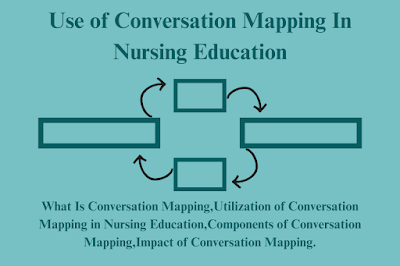What is Use of Conversation Mapping In Nursing Education. Conversation mapping in nursing education helps students visualize and understand complex concepts and relationships within patient care plans, ultimately improving their critical thinking and problem-solving skills. It facilitates a more holistic understanding of a patient’s condition, linking diagnoses, assessments, interventions, and outcomes.
The Use of Conversation Mapping In Nursing Education
Conversation Mapping is an innovative educational tool designed to facilitate interactive learning through visual aids. Developed by Merck & Company, Healthy Interactions, the American Diabetes Association, and the Canadian Diabetes Association, Conversation Maps are colorful, engaging tabletop displays that help participants better understand and contextualize information (Healthy Interactions, n.d.).
These maps are utilized in a variety of settings, including health education, to promote active participation and deeper comprehension of complex topics. Available in 35 languages and used in 110 countries, Conversation Maps are a testament to their widespread acceptance and effectiveness in enhancing learning experiences.
Utilization of Conversation Mapping in Nursing Education
In nursing education, Conversation Maps are a relatively novel pedagogical tool. They were originally created for patients with specific diseases, particularly diabetes mellitus, but their application in educational settings for nursing students represents a new and innovative approach. The use of Conversation Maps in secondary education is grounded in the understanding that college-age students often thrive in collaborative, socially oriented, and team-based learning environments (Croasdale, 2008; Matulich, Papp, & Haytko, 2008; McGlynn, 2007). These students benefit from interactive and engaging learning experiences that promote teamwork and active participation.
Several studies have highlighted the importance of creating collaborative, active, and intellectually stimulating learning environments (Matulich et al., 2008). Conklin (2013) reviewed literature suggesting that effective learning environments should include listening, opportunities for discussion, positive feedback, responsiveness to questions and comments, and acknowledgment of diverse perspectives and experiences. Conversation Maps align well with these recommendations by providing an interactive, participatory, and experiential learning experience. For instance, Strang, Bagnardi, and Utz (2010) describe how Conversation Maps were used with undergraduate nursing students to teach about diabetes management. The hands-on nature of Conversation Maps helps bridge the gap between theoretical knowledge and practical application.
Components of Conversation Mapping
Conversation Maps consist of several key components that enhance their effectiveness as a teaching tool:
- Visual Aids: The maps feature bright, colorful graphics that are designed to be visually engaging and easy to understand. These visuals help in simplifying complex information and making it more accessible to learners.
- Interactive Elements: Conversation Maps encourage active participation through discussions and interactions. This interactive approach helps students engage with the material more deeply and facilitates a better understanding of the content.
- Facilitator Guidance: Trained facilitators are crucial for the effective use of Conversation Maps. They guide the discussion, help clarify concepts, and ensure that all participants are actively involved in the learning process. The facilitator’s role is to enhance the learning experience and ensure that the objectives of the session are met.
Research has primarily focused on the outcomes of Conversation Mapping with adult patients, particularly those with diabetes (Monk, 2010; Reaney, Eichorst, & Gorman, 2012; Sperl-Hillen et al., 2013). These studies have demonstrated positive short-term results and high participant satisfaction. However, there is a need for more research to explore the long-term effects of using Conversation Maps in educational settings. Despite this, the interactive, participative, and experiential nature of Conversation Maps makes them a valuable addition to traditional classroom formats, offering benefits that extend beyond conventional teaching methods.
Impact of Conversation Mapping
The impact of Conversation Mapping in nursing education is multifaceted. Healthcare providers and educators are increasingly tasked with creating learning environments that cater to diverse learner needs, including generational factors, learning styles, and individual characteristics. Conversation Maps address these needs by providing an engaging and interactive platform for learning.
The use of Conversation Maps in health-related classes serves a dual purpose: it fosters active participation and introduces students to a novel educational tool. This approach aligns with contemporary educational trends that emphasize student-centered learning and the integration of technology in education. The positive feedback from initial studies suggests that Conversation Maps have the potential to enhance learning outcomes and improve student engagement.
However, it is important to recognize that Conversation Maps are still relatively new in both healthcare and secondary education settings. While early results are promising, further research is needed to fully understand their impact and effectiveness. Future studies should focus on evaluating the long-term benefits of Conversation Maps, exploring their applicability across different subject areas, and assessing their potential for widespread adoption in nursing education.
Conclusion
Conversation Mapping represents an exciting advancement in educational methodology, particularly in nursing education. By leveraging visually engaging, interactive, and participatory elements, Conversation Maps provide a dynamic learning experience that aligns with modern educational principles. They offer a promising alternative to traditional teaching methods, fostering deeper engagement and understanding among students.
As the field of nursing education continues to evolve, integrating innovative tools like Conversation Maps can enhance learning outcomes and better prepare students for their professional roles. Continued research and application of Conversation Maps will be crucial in determining their long-term impact and effectiveness. With their potential to transform the learning experience, Conversation Maps hold significant promise for the future of nursing education and beyond.
Read More:
https://nurseseducator.com/didactic-and-dialectic-teaching-rationale-for-team-based-learning/
https://nurseseducator.com/high-fidelity-simulation-use-in-nursing-education/
First NCLEX Exam Center In Pakistan From Lahore (Mall of Lahore) to the Global Nursing
Categories of Journals: W, X, Y and Z Category Journal In Nursing Education
AI in Healthcare Content Creation: A Double-Edged Sword and Scary
Social Links:
https://www.facebook.com/nurseseducator/
https://www.instagram.com/nurseseducator/
